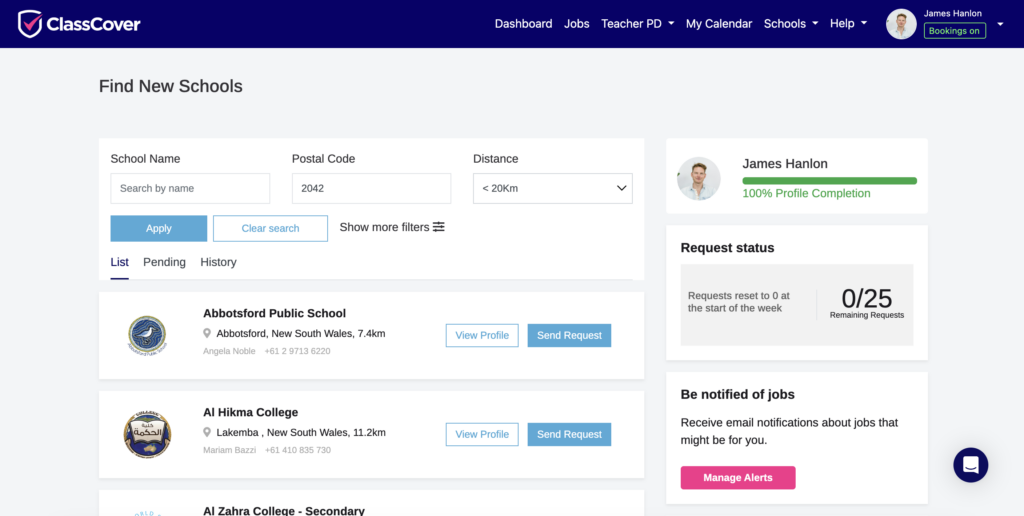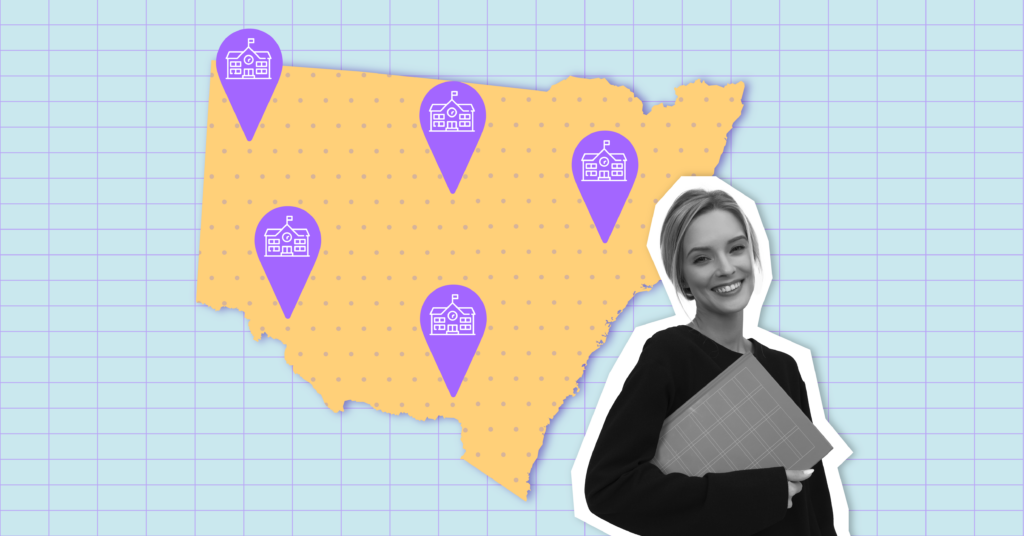Interested in casual teaching in NSW? In this blog we answer some of the internet’s most asked questions about becoming a casual relief teacher in Sydney and New South Wales. So, if you’re wondering how to become a teacher in NSW, how much NSW teachers get paid, what to put in a NSW teacher resume, where to find casual teacher jobs in Sydney and more — read on.
How to Become a Teacher in NSW
To become a teacher in NSW, hopeful educators must complete studies in education at a recognised university that meets the NSW Education Standards Authority (NESA) academic requirements for teachers. Additionally, prospective teachers must satisfy several criteria like proficiency in English and must also be able to acquire a NSW Working with Children Check (WWCC). Want to know more about how to become a teacher in NSW? Keep reading to learn more about each step.
1. Complete an education degree that is recognised by NESA
Most teachers in NSW complete one of two types of degrees: A four-year undergraduate teaching degree e.g., Bachelor of Education, or an undergraduate degree in another area followed by a graduate entry teaching degree e.g., Master of Teaching. Depending on the type of teaching role you want, there may be additional subject requirements that you need to satisfy. Read about the specific subject requirements here.
2. Prove your proficiency in English
If your teaching qualification is from a country where English is not the main language, you will also need to show evidence of successful completion of the International English Language Testing System (IELTS). If you want to teach in NSW, you must score at least a 7 in reading and writing and 8 in speaking and listening. Learn more from the NSW Department of Education here.
3. Obtain a current NSW Working with Children Check (WWCC)
Before applying for a teaching role in New South Wales, you must obtain a WWCC. Here is more information on the process.
4. Register with NESA
Once you have satisfied the criteria above, you can apply for registration with NESA. Depending on your education level, you can be given either conditional or provisional accreditation. Learn more about registering as a teacher with NESA.
5. Register with ClassCover
ClassCover is the chosen booking platform for the majority of schools in New South Wales, including most public schools, and many Catholic and independent schools, too. Free for teachers, all you have to do is download the app, create your profile and you’re free to start reaching out to schools in your area. Once a school adds you to their list of teachers, you will begin receiving booking requests straight to your phone. Create your free ClassCover profile here.
6. Continue your professional development
NSW, like all states and territories in Australia requires all teachers to complete professional development to maintain their accreditation. This consists of 100 hours of professional learning over the 5-year registration period, of which 50 hours must be made up of NESA accredited PD. Read more on that below.
It’s worth noting that the points above are for teachers in NSW public schools. Requirements may differ in catholic and independent schools as well as any outside of the public system.
7. Complete mandatory training
Casual teachers in NSW must stay up to date with a range of mandatory training covering first aid and more. These can be accessed within the NSW Department of Education staff portal. The good news is, once you have completed your mandatory training you can always check that you are up to date by looking for the green tick next to your name on your ClassCover profile.
Casual Teacher NSW Pay
So, how much do NSW teachers get paid? For casual teachers, the pay in NSW public schools will depend on a few factors, like your level of accreditation and experience. Teachers with graduate level NESA accreditation will be paid a daily rate of $439.66. This increases based on experience and accreditation level up to a maximum daily rate of $548.95. For all teachers, these daily rates include extra for holiday pay and sick leave. These rates may differ in catholic and independent schools. See more information on teacher pay in NSW from the NSW Department of Education.
Teacher Professional Development NSW
As we mentioned above, all teachers in NSW, whether you are a full-time classroom teacher, a casual relief teacher, or sit somewhere in between, need to complete 100 hours of professional development for each 5-year registration period. 50 of those hours are elective PD, and can include things like professional mentoring, postgraduate study, and attending conferences or workshops. The other 50 hours must be NESA-accredited PD from the NSW Department of Education priority areas — more on that here.
While full-time classroom teachers tend to have the benefit of being paid to undertake PD by their employers, most casual relief teachers aren’t so lucky. If you’re looking for a flexible, cost-effective way to complete your teacher PD, ClassCover Learn has over 100 hours of on-demand, online teacher PD including over 20 hours of NESA accredited courses available for $99 per year. Learn more about ClassCover Learn.
Casual Teacher Jobs – Sydney and NSW
Once you are ready to start working as a teacher in NSW, there are two main ways to for casual teacher jobs.
- Connect with schools in your area
After creating your teacher profile on ClassCover, you’re ready to start connecting with schools in your area. From the Find New Schools page, browse the list of schools or filter by post code, school name and more.

When you see a school that you like the look of, send a request to be added to their list. Also keep an eye on your School Invites — this is where schools who see your profile can request for you to join their pool of teachers.
- Browse casual teacher jobs across Sydney and NSW
ClassCover Jobs is the best way to hear about new casual teacher jobs as well as part-time, full-time, and contract opportunities in Sydney and around NSW. No matter what sort of teaching job you’re looking for, it’s a good idea to check ClassCover Jobs as new opportunities are posted daily.
Teacher Resume NSW
Before you apply for a new role in education, it’s a good idea to update your teacher resume. We know it can be a minefield deciding which information to include on your resume, particularly if you’re new to teaching or if it’s been a while since you last changed jobs. Here’s some tips on the key details to include on your teacher resume:
- Your contact details
This may sound like a no brainer, but having the correct contact details clearly displayed on your resume can mean the difference between getting the teaching job of your dreams or being left hanging. At a minimum, it’s a good idea to include your phone number and email address. If you really want to stand out, include a link to your ClassCover Teacher Portfolio.
- Availability
Particularly if you are applying for work as a casual teacher in NSW, it’s important to include your general availability for schools to see at a glance. This will make things as easy as possible for the person doing the hiring and give you the best chance of getting a callback.
- Work history
Make sure you include a summary of your recent and relevant work experience. No, those 6 months you spend scooping ice cream in high school probably don’t need to be on your teacher resume, but any experience that relates to the role you are applying for should be.
- Qualifications and PD courses
To help you stand out from other candidates, include any relevant qualifications or PD courses you have completed that would help you in the role.



